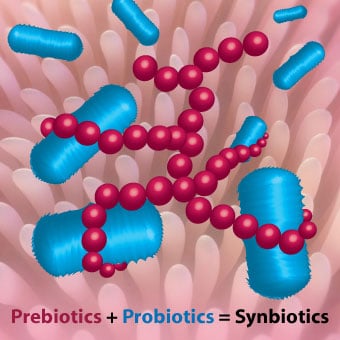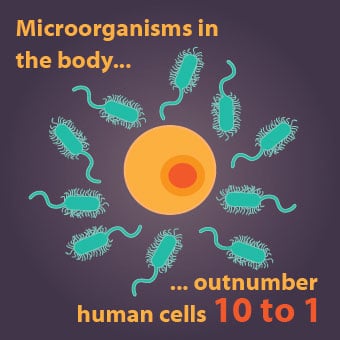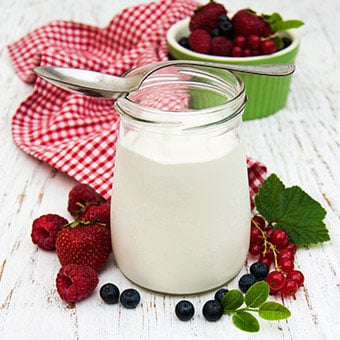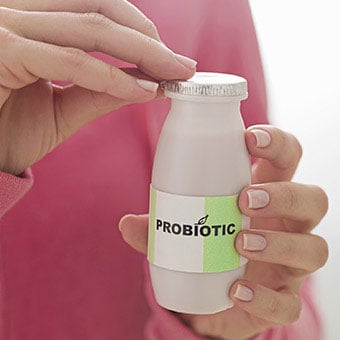Probiotics

What are probiotics?
The idea that bacteria are beneficial can be tough to understand. We take antibiotics to kill harmful bacterial infections and use antibacterial soaps and lotions more than ever. The wrong bacteria in the wrong place can cause problems, but the right bacteria in the right place can have benefits. This is where probiotics come in. Probiotics are live microorganisms that may be able to help prevent and treat some illnesses. Promoting a healthy digestive tract and a healthy immune system are their most widely studied benefits at this time. These are also commonly known as friendly, good, or healthy bacteria. Probiotics can be supplied through foods, beverages, and dietary supplements.
The root of the word probiotic comes from the Greek word pro, meaning "promoting," and biotic, meaning "life." The discovery of probiotics came about in the early 20th century, when Elie Metchnikoff, known as the "father of probiotics," had observed that rural dwellers in Bulgaria lived to very old ages despite extreme poverty and harsh climate. He theorized that health could be enhanced and senility delayed by manipulating the intestinal microbiome with host-friendly bacteria found in sour milk. Since then, research has continued to support his findings along with suggesting even more benefits.

What are probiotics? (Continued)
In October 2013, the International Scientific Association for Probiotics and Prebiotics (ISAPP) organized a meeting of clinical and scientific experts on probiotics (with specialties in gastroenterology, pediatrics, family medicine, gut microbiota, microbiology of probiotic bacteria, microbial genetics, immunology, and food science) to reexamine the concept of probiotics. They define probiotics as "live microorganisms that, when administered in adequate amounts, confer a health benefit on the host." They also differentiated between products containing probiotics and those containing live or active cultures and established the following criteria:
- Live or active cultures criteria:
- Any food with fermentation microbe(s)
- Proof of viability at a minimum level reflective of typical levels seen in fermented foods, suggested to be 1 × 109 CFU per serving
- No specific research or evidence is needed to make this claim.
- Probiotics criteria for products that do not make a health claim:
- A member(s) of a safe species, which is supported by sufficient evidence of a general beneficial effect in humans or a safe microbe(s) with a property (for example, a structure, activity, or end product) for which there is sufficient evidence for a general beneficial effect in humans
- Proof of viability at the appropriate level used in supporting human studies
- Probiotics criteria for products that make a health claim:
- Defined probiotic strain(s)
- Proof of delivery of viable strain(s) at efficacious dose at the end of shelf life
- Convincing evidence needed for specific strain(s) or strain combination in the specified health indication
Our body normally has what we would call good or helpful bacteria and bad or harmful bacteria. Maintaining the correct balance between these bacteria is necessary for optimal health. Age, genetics, and diet may influence the composition of the bacteria in the body (microbiota). An imbalance is called dysbiosis, and this has possible links to diseases of the intestinal tract, including ulcerative colitis, irritable bowel syndrome, celiac disease, and Crohn's disease, as well as more systemic diseases such as obesity and type 1 and type 2 diabetes. How do you know if you need probiotics? This article will help you decide.

What are prebiotics and synbiotics?
The prebiotic comes before and helps the probiotic, and then the two can combine to have a synergistic effect, known as synbiotics. A prebiotic is actually a nondigestible carbohydrate that acts as food for the probiotics and bacteria in your gut. The definition of the effect of prebiotics is the selective stimulation of growth and/or activity(ies) of one or a limited number of microbial genus(era)/species in the gut microbiota that confer(s) health benefits to the host. The health benefits have been suggested to include acting as a remedy for gastrointestinal (GI) complications such as enteritis, constipation, and irritable bowel disease; prevention and treatment of various cancers; decreasing allergic inflammation; treatment of nonalcoholic fatty liver disease (NAFLD), and fighting immune deficiency diseases. There has also been research showing that the dietary intake of particular food products with a prebiotic effect has been shown, especially in adolescents, but also tentatively in postmenopausal women, to increase calcium absorption as well as bone calcium accretion and bone mineral density. The benefits for obesity and type 2 diabetes are growing as recent data, both from experimental models and from human studies, have shown particular food products with prebiotics have influences on energy homeostasis, satiety regulation, and body weight gain.
Most of the prebiotics identified are oligosaccharides. They are resistant to the human digestive enzymes that work on all other carbohydrates. This means that they pass through the upper GI system without being digested. They then get fermented in the lower colon and produce short-chain fatty acids that will then nourish the beneficial microbiota that live there. Oligosaccharides can be synthesized or obtained from natural sources. These sources include asparagus, artichoke, bamboo shoots, banana, barley, chicory, leeks, garlic, honey, lentils, milk, mustards, onion, rye, soybean, sugar beet, sugarcane juice, tomato, wheat, and yacón. The health benefits from these oligosaccharides is a topic of ongoing research.

What are microbes and their role in our health?
Microbes are tiny organisms (bacteria, viruses, parasites, or fungi) -- so tiny that millions can fit into the eye of a needle -- that are so powerful that an imbalance in the body is related to numerous diseases. These microorganisms can be found in almost every part of the human body, living on the skin, in the nose, and in the gut. There are trillions of these microorganisms in our bodies. They outnumber human cells by 10 to one, but due to their small size, they only make up 1%-3% of a body's total mass.
The National Institute of Health (NIH) is sponsoring the Human Microbiome Project (HMP), which is developing research resources to enable the study of the microbial communities that live in and on our bodies and the roles they play in human health and disease. The NIH has funded many more medical studies using HMP data and techniques, including the role of the gut microbiome in Crohn's disease, ulcerative colitis, and esophageal cancer; skin microbiome in psoriasis, atopic dermatitis, and immunodeficiency; urogenital microbiome in reproductive and sexual history and circumcision; and a number of childhood disorders, including pediatric abdominal pain, intestinal inflammation, and necrotizing enterocolitis, a severe condition in premature infants in which the intestine tissue dies due to lack of oxygen.

What are the health benefits of probiotics?
Probiotics may seem new to the food and supplement industry, but they have been with us from our first breath. During a delivery through the birth canal, a newborn picks up the bacteria Bacteroides, Bifidobacterium, Lactobacillus, and Escherichia coli from his/her mother. These good bacteria are not transmitted when a Cesarean section is performed and have been shown to be the reason why some infants born by C-section have allergies, less than optimal immune systems, and lower levels of gut microflora.
What exactly do probiotics do? They are believed to protect us in two ways. The first is the role that they play in our digestion. We know that our digestive tract needs a healthy balance between the good and bad gut bacteria, so what gets in the way of this? It looks like our lifestyle is both the problem and the solution. Poor food choices, emotional stress, lack of sleep, antibiotic overuse, other drugs, and environmental influences can all shift the balance in favor of the bad bacteria.

What are the health benefits of probiotics? (Continued)
When the digestive tract is healthy, it filters out and eliminates things that can damage it, such as harmful bacteria, toxins, chemicals, and other waste products. The healthy balance of bacteria assists with the regulation of gastrointestinal motility and maintenance of gut barrier function. Research has shown some benefits for the use of probiotics for infectious diarrhea, antibiotic-associated diarrhea, gut transit, IBS, abdominal pain and bloating, ulcerative colitis, Helicobacter pylori infection, nonalcoholic fatty liver disease (NAFLD), and necrotizing enterocolitis.
The other way that probiotics help is the impact that they have on our immune system. Some believe that this role is the most important. Our immune system is our protection against germs. When it doesn't function properly, we can suffer from allergic reactions, autoimmune disorders (for example, ulcerative colitis, Crohn's disease, and rheumatoid arthritis), and infections (for example, infectious diarrhea, H. pylori, skin infections, and vaginal infections). By maintaining the correct balance from birth, the hope would be to prevent these ailments. Our immune system can benefit anytime that balanced is restored, so it's never too late.
Research into the benefits of probiotics has been branching out, and new areas are emerging. Preliminary research has linked them to supporting the health of the reproductive tract, oral cavity, lungs, skin and gut-brain axis, and the prevention and treatment of obesity and type 1 and type 2 diabetes.

What are the different types of probiotics?
Probiotic supplements, foods, and beverages contain bacteria and/or yeasts. Up until the 1960s, the only gut microflora that they were able to identify were clostridia, lactobacilli, enterococci, and E. coli. Since then, innovative techniques have discovered many more bacteria.
There are several different kinds of probiotics, and their health benefits are determined by the job that they do in the gut. They must be identified by their genus, species, and probiotic strain level. Here is a list of probiotics and their possible health benefits.
1. Lactobacillus
There are more than 50 species of lactobacilli. They are naturally found in the digestive, urinary, and genital systems. Foods that are fermented, like yogurt, and dietary supplements also contain these bacteria. Lactobacillus has been used for treating and preventing a wide variety of diseases and conditions.
Some of the lactobacilli found in foods and supplements are Lactobacillus acidophilus, L. acidophilus DDS-1, Lactobacillus bulgaricus, Lactobacillus rhamnosus GG, Lactobacillus plantarium, Lactobacillus reuteri, Lactobacillus salivarius, Lactobacillus casei, Lactobacillus johnsonii, and Lactobacillus gasseri.
Studies have shown some benefits linked to Lactobacillus and treating and/or preventing yeast infections, bacterial vaginosis, urinary tract infection, irritable bowel syndrome, antibiotic-related diarrhea, traveler's diarrhea, diarrhea resulting from Clostridium difficile, treating lactose intolerance, skin disorders (fever blisters, eczema, acne, and canker sores), and prevention of respiratory infections.

What are the different types of probiotics? (Part 2)
2. Bifidobacteria
There are approximately 30 species of bifidobacteria. They make up most of the healthy bacteria in the colon. They appear in the intestinal tract within days of birth, especially in breastfed infants and are thought to be the best marker of intestinal health.
Some of the bifidobacteria used as probiotics are Bifidobacterium bifidum, Bifidobacterium lactis, Bifidobacterium longum, Bifidobacterium breve, Bifidobacterium infantis, Bifidobacterium thermophilum, and Bifidobacterium pseudolongum.
Studies have shown that bifidobacteria can help with improving blood lipids and glucose tolerance. Bifidobacteria have been shown to effectively alleviate IBS and significantly improve IBS symptoms like pain/discomfort, distension/bloating, urgency, and digestive disorders.

What are the different types of probiotics? (Part 3)
3. Saccharomyces boulardii
This is also known as S. boulardii and is the only yeast probiotic. Some studies have shown that it is effective in preventing and treating diarrhea associated with the use of antibiotics and traveler's diarrhea. It has also been reported to prevent the reoccurrence of C. difficile, to treat acne, and to reduce side effects of treatment for H. pylori.
4. Streptococcus thermophilus
This produces large quantities of the enzyme lactase, making it effective, according to some reports, in the prevention of lactose intolerance.
5. Enterococcus faecium
This is normally found in the intestinal tract of humans and animals.
6. Leuconostoc
This has been used extensively in food processing throughout human history, and ingestion of foods containing live bacteria, dead bacteria, and metabolites of these microorganisms has taken place for a long time.

What foods contain probiotics?
The discovery of the benefits of probiotics began with sour milk. Today we have many other options to get various bacteria from our foods, although it's not as simple as just adding them to the food. For there to be health benefits, the microorganism has to be able to survive the passage through the gastrointestinal tract, survive the food manufacturing process, and grow and survive during the ripening or storage period. Also, the bacteria must not negatively affect product quality and be included on the Generally Recognized as Safe (GRAS) list.
Most bacteria are included through the fermentation process. Fermentation helps extend the shelf life of perishable foods. It is a slow decomposition process of organic substances induced by microorganisms or enzymes that essentially convert carbohydrates to alcohols or organic acids. The lactic acid supplies the bacteria that then add the health benefits to the food. You can purchase foods that are fermented or ferment them yourself.
- Kefir: This could be the most ideal probiotic dairy product because it contains both bacteria and yeast working together to provide the numerous health benefits. In a recent eight-week study, people with diabetes were given kefir milk containing Lactobacillus casei, Lactobacillus acidophilus, and bifidobacteria vs. conventional fermented milk. The hemoglobin A1C levels were significantly lower in the group consuming the kefir.

What foods contain probiotics? (Part 2)
- Kimchi: This fermented vegetable is made from Chinese cabbage (beachu), radish, green onion, red pepper powder, garlic, ginger, and fermented seafood (jeotgal). Many bacteria have been found to be present and can include any of the following: Leuconostoc mesenteroides and Lactobacillus plantarum, L. mesenteroides, L. citreum, L. gasicomitatum, L. brevis, L. curvatus, L. plantarum, L. sakei, L. lactis, Pediococcus pentosaceus, Weissella confusa, and W. koreensis. A recent review linked the health benefits of kimchi to anticancer, antiobesity, anticonstipation, colon health promotion, cholesterol reduction, antioxidative and antiaging properties, brain health promotion, immune promotion, and skin health promotion.

What foods contain probiotics? (Part 3)
- Yogurt: It can contain Streptococcus thermophilus, Lactobacillus bulgaricus, L. acidophilus, and Bifidobacterium bifidum. Research has shown links with yogurt to have positive effects on the gut microbiota and is associated with a reduced risk for gastrointestinal disease and improvement of lactose intolerance (especially among children), type 2 diabetes, cardiovascular disease, allergies and respiratory diseases, as well as improved dental and bone health.
- Sweet acidophilus milk: L. acidophilus and L. acidophilus plus bifidobacteria are added to make this milk.
- Other foods without substantial research: miso (fermented soybean paste); tempeh; sauerkraut; aged soft cheese; sourdough bread; sour pickles; gundruk (nonsalted, fermented, and acidic vegetable product); sinki (indigenous fermented radish tap root food); khalpi (fermented cucumber); inziangsang (traditional fermented leafy vegetable product prepared from mustard leaves); soidonis (widespread fermented product prepared from the tip of mature bamboo shoots)

What are the side effects and risks of probiotics?
Supplements play an important role when the diet is not adequate to supply our needs. In the case of probiotics, one's diet is the ideal source for probiotics. These are live bacteria and need to be carefully monitored, stored, and combined for the health benefits that one would be taking them for. At this time, probiotic supplements are not monitored in the U.S. the way that food or medication is. They fall under the Dietary Supplement Health and Education Act of 1994 (DSHEA). This requires that the dietary supplement or dietary ingredient manufacturer be responsible for ensuring that a dietary supplement or ingredient is safe before it is marketed. The only time that the U.S. Food and Drug Administration (FDA) may get involved is if action is needed to be taken against a manufacturer after the supplement is marketed and then found to be unsafe. This means that as much as we may know about probiotics, we can't be certain of the safety or content of the supplements available to us.
There is one Voluntary Certification Program by which a supplement manufacturer can choose to be evaluated. ConsumerLab.com (CL) is the leading provider of independent test results and information to help consumers and health-care professionals identify the best quality health and nutrition products. Products that have passed their testing for identity, strength, purity, and disintegration can print the CL Seal of Approval on their product. This is one step toward being confident that one is getting the amount and type of probiotic promised by the manufacturer.
Caution needs to be taken by everyone who chooses to take these supplements, but this is especially true for children, pregnant women, elderly people, and people with compromised immune systems. For people with compromised immune systems due to disease or treatment for a disease (such as cancer chemotherapy), taking probiotics may actually increase one's chances of getting sick. It has been shown that the use of various probiotics for immunocompromised patients or patients with a leaky gut has resulted in infections and sepsis (infection of the bloodstream). One case of bacteremia (bacteria in the bloodstream) was recently found when someone with active severe inflammatory bowel diseases with mucosal disruption was given Lactobacillus GG. Always speak with a doctor before taking any supplement under these circumstances.

How should people take probiotics?
The requirements for a microbe to be considered a probiotic are that the microbe must be alive when administered, it must be documented to have a health benefit, and it must be administered at levels to confer a health benefit. A rule of thumb often cited is to take at least a billion colony forming units (CFUs) daily.
These are live microorganisms that will not provide the promised benefits if they don't remain alive. The manufacturer and consumer must pay close attention to the conditions of storage at which the particular microorganism will survive and the end of their shelf life. The potency will indicate the number of viable bacteria per dose, and the purity has to do with presence of contaminating or ineffective bacteria.
The other thing to remember is that these microorganisms are not all created equally. In fact, the genus, strain, and species all need to be the same for the results that found in the study to be the results that one hopes to achieve when taking it. For example, with the strain Lactobacillus rhamnosus GG, the genus is Lactobacillus, the species is rhamnosus, and the strain is GG. If any one of those is different in your supplement, you may not attain the same results.
With the growing popularity of probiotics, there is a huge variety of supplements from which one can choose. The most important thing is to determine what type of probiotic microorganism you need for your condition. Do not just take the supplement that provides the most kinds of organisms. You need to do your research and be sure that there are scientific studies to support what you take. New research is emerging, so if you don't find what you need right now, keep looking. A doctor can help one decide if trying probiotics might be helpful for you and can advise you regarding the amount and type of probiotics that may be appropriate in your case.

